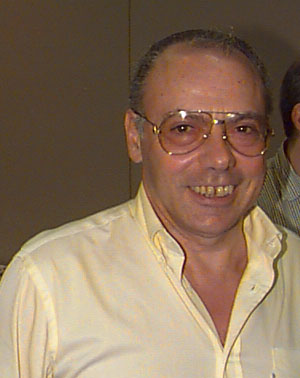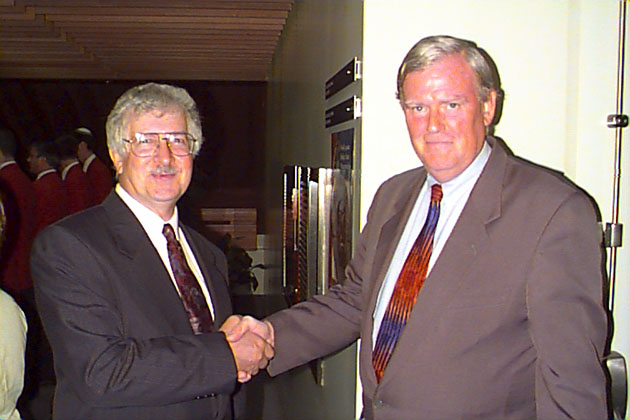| Contents |
|
6th World Junior Bridge Teams Championship DAILY BULLETIN Editor: M. Horton • Co-Editor: R. Lee Web Editor: Th. Matziaris No.: 1 • Monday, 4 August 1997 |
| Contents |
| The Curtain Rises |
 |
|
Months of careful planning and hard work came to fruition
yesterday when the Sixth World Junior Championships were formally opened by José
Damiani, the President of the World Bridge Federation.
The opening ceremony was preceded by a reception given by the Mayor of the City of Hamilton, Bob Morrow. The early part of the evening also afforded an opportunity for team pictures to be taken in front of the official scoreboard, alongside two officers of the Royal Canadian Mounted Police in full ceremonial uniform. |
|
WBF Youth Committee Chairman Panos Gerontopoulos welcomed the participants, contrasting this event with the inaugural championship in Amsterdam ten years ago. In 1987, five teams from four zones took part; this year, all seven zones are represented, with eighteen teams from sixteen countries present in Hamilton. He thanked the Organizing Committee chairman, John Carruthers, and the rest of the people who had worked so hard to make the Hamilton tournament a reality. | ||
 | ||
| Other welcome messages were delivered by Bob Morrow,
the Mayor of Hamilton, who said that he intended to come and watch some of the
bridge during the week, and Doug Heron, representing the Canadian Bridge
Federation, who expressed the hope that a tradition of victory for the host
nation, established in the first three championships, would be reinstated this
year.
Finally, after a satisfying dinner, master of ceremonies Stefan Back wished everyone an enjoyable tournament, and introduced Canadian National Ballet pianist Gary Arbour, who entertained the gathering with a bravura performance of several works by Chopin. | ||
| Gazing in our Crystall Ball |
|
It is customary to handicap teams at the beginning of a major event like a world championship, and to try to predict the finalists. This is especially challenging in an event like a junior team championship because so many of the players have not yet established their reputations, at least beyond their local communities. However, the bulletin staff is never shy about accepting a challenge. So here is our attempt at handicapping, the 6th World Junior Team Championship. Both Denmark and Norway can be expected to finish well. Denmark has an excellent track record in this event and 4 of their 6 players were on the team that won the bronze medal in Bali; Norway, the reigning European Junior Champions, is known to be a strong team. Russia, too, will be a powerful competitor; one of their pairs played extremely well at the Olympiad in Rhodes where they made the quarter finals. Canada Red has 5 of the 6 players back from their fourth place team in Bali and several players from USA II have just made an extremely good showing at the ACBL Summer Nationals in Albuquerque. China and Chinese Taipei are both likely to be contenders since they have very strong bridge programs. In fact, we won't be surprised whichever of the teams coming to Hamilton win places amongst the final four. Based on the above, the bulletin staff each selected their top four. While everyone had a slightly different selection. the consensus was that the finalists are likely to come from the following seven teams (in alphabetical order): Canada Red, China, Denmark, Israel, Norway, Russia, and USA II. |
| Bali High |
|
As the players gather to compete for the 6th World Junior Bridge Team Championship in Hamilton, Canada, let's recall the highlights of the fifth event, which took place two years ago and almost 15,000 kilometres away in Bali, Indonesia. Twelve teams took part, compared to the eighteen expected to play in Hamilton. A complete round-robin of 32-board matches was played, with four teams to qualify for the knockout stage of the competition. First place was never in doubt, as the favoured Great Britain team ran away from the rest of the field. The remaining three places were won by Denmark, New Zealand, and Canada, and the failure of either USA team to qualify occasioned some surprise. Great Britain proved themselves well worthy of the championship, beating Canada easily in the semi-final, and having only somewhat more trouble disposing of New Zealand in the final. Denmark rebounded from the semi-final disappointment to win the bronze medal in a play-off against Canada. This hand from the round-robin stage in Bali features the Madsen brothers (Lars and Morten) from Denmark, as they find a neat defence against Joel Wooldridge and Tom Carmichael of the USA.
Lars found the best lead - the
Winning with the
Now Morten cashed the
When Denmark and New Zealand played this board, East became
declarer in 5 The same net result (4 IMPs ) also occurred in the other match, but the path to it was quite dissimilar. Everybody liked spades in the Open Room. Davies must have been increasingly bemused to hear the Canadian pair bid more and more of them, and had little trouble making his final decision over Souter's forcing pass. He led the Now Sutherland made the natural, but fatal, error of playing a
trump; Davies drew three rounds and then reverted to diamonds,
eventually collecting 1100. In the Closed Room, the Hackett twins found
themselves on the receiving end of some aggressive Canadian bidding.
Jason's 3 Now put yourself in Jason's shoes as he tried to figure all this
out, and make the right lead against 6 Six of the Bali medallists are back in Hamilton, looking for gold this time. While Great Britain did not qualify from Zone 1 to defend its title this year, four of the Danish squad from Bali are here, and Ishmael Del'Monte, previously with New Zealand, is now playing for Australia. The fourth place Canadian team survives in Hamilton as Canada Red, also with only one change. And we don't doubt that the returning Americans will be determined to prove that 1997 is their year. | |||||||||||||||||||||||||||||||||||||||||||||||||||||||||||||||||||||||||||||||||||||||||||||||||||||||||||||||||||||||||||||||||||||||||||||||||||||||||||||||||||||||||||||||||||||||||||||||||||||||||||||||||||||||||||||||||||||||||||||||
| To List of Bulletins |